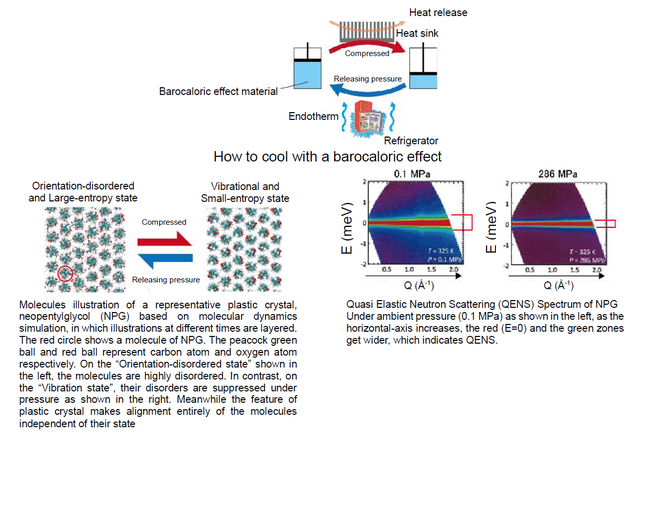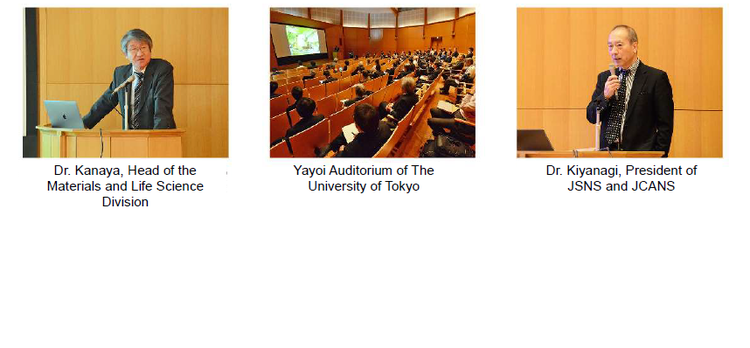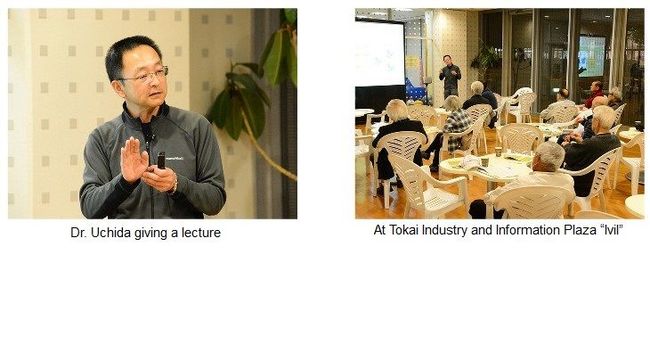J-PARC NEWS April 2019 (Issue #168)
■High Expectations for Development of New Cooling Technology Using Solid Refrigerant -- Elucidating a Mechanism Where Changes in Molecular Motion Accompanying Pressure Changes in a "Plastic Crystal" Cause "Colossal Caloric Effects" -- (March 29, Press Release)
There are growing expectations for cooling technology using solid refrigerants as a replacement for gaseous refrigerants like chlorofluorocarbons for which there are concerns about environmental impact. These solid refrigerants have caloric effects of producing or absorbing heat due to external factors such as magnetic or electric fields. In this research, the first step was confirming the large caloric effects due to pressure changes of a plastic crystal with properties intermediate between liquid and solid. Next, as the underlying mechanism, it was confirmed that colossal barocaloric effect can be achieved by pressure-induced phase transitions between the orientational-disordered state where molecules in the crystal can freely rotate in the lattice (at normal pressure) and the vibrational state where they can only vibrate in specific directions (at high pressure). In the orientational-disordered state, the molecules are oriented more randomly than in the vibration state. Therefore, the entropy (a physical quantity expressing "disorder" of the system at the micro level) is large, and a large amount of heat is absorbed corresponding to the increase in entropy. The state of motion of molecules was investigated through neutron quasi-elastic and inelastic scattering experiments using AMATERAS, a cold neutron disk chopper spectrometer at J-PARC. When the molecules are in rotational motion, the incident neutrons experience quasi-elastic scattering. In the figure, the fact that the quasi-elastic scattering due to free rotational motion of molecules seen at normal pressure is not evident at high pressure indicates that free rotational motion has stopped at high pressure. It is expected that this elucidation at the atomic level of the mechanism of barocaloric effects will advance the investigation and design of materials having barocaloric effects with even better performance.
■Naohito Saito, Director of the J-PARC Center, Delivers Keynote Address "Accelerating the Future with a High-Intensity Proton Accelerator" at the Annual Meeting in Spring 2019 of the Atomic Energy Society of Japan (March 20, Ibaraki University)
From March 20 to 22, the Annual Meeting in Spring 2019 of the Atomic Energy Society of Japan was held at the Mito Campus of Ibaraki University. In the keynote address on the first day, Naohito Saito, Director of the J-PARC Center, provided an overview of J-PARC facilities and discussed research results in a speech on the topic "Accelerating the Future with a High-Intensity Proton Accelerator." Dr. Saito pointed out that, at J-PARC, various secondary particles are produced using a world-class proton beam, and academic research into the origins of the universe, life, and matter is being conducted using mesons and other particles. He also noted that use by industry is growing, such as development of eco-tires using neutrons, and all solid-state batteries using ceramics for the electrolyte layer.

■Eiichi Wakai, Taku Ishida and Others Receive the First Best Figure Award of the Materials Science and Technology Division, Atomic Energy Society of Japan
The purpose of the Materials Science and Technology Division, Atomic Energy Society of Japan, is to promote development and progress in the field of nuclear power materials, and a decision has been made to present Division awards (Achievement Award, Outstanding Young Researcher Award, Best Figure Award) to individuals or groups who have made notable contributions in the pertinent field and are regular members of the Materials Science and Technology Division. This time, the first Best Figure Award of the Materials Science and Technology Division, Atomic Energy Society of Japan, was presented, at a general meeting of the division on March 20, to Dr. Eiichi Wakai*1 and Dr. Taku Ishida*2 of the J-PARC Center, two researchers from PNNL*3, and one researcher from Fermilab*4 for their work titled "Structure Image of Ti Alloy from RaDIATE International Collaborative Research and a Moment at PNNL" in recognition of its great academic interest and beauty, and its contribution to research and technology development for nuclear power materials.
*1 Material & Life Science Division, *2 Neutrino Section, *3 Pacific Northwest National Laboratory, *4 Fermi National Accelerator Laboratory
■Held 4th J-PARC/Media Meetup (March 19, Tokyo)
A Media Meetup was held to showcase the cutting-edge research activities at the J-PARC Center to a broad range of media. On the day of the meeting, 10 individuals and 8 media companies participated, and Toshiji Kanaya, Head of the Materials & Life Science Division, provided an overview of J-PARC and research results. Then Deputy Head Yasuhiro Miyake gave a report entitled "The World Inside Matter Seen with Muons" and Yukinobu Kawakita, Sub Leader of the Neutron Science Section of the Division, gave a talk entitled "New Routes to Enhancing Performance of Energy Conversion Devices". There was a lively question and answer period, and strong interest in J-PARC was evident.

■Held T2K Collaboration Meeting (March 25-29, IQBRC)
From March 25 to 29, a T2K Collaboration Meeting was held at the Ibaraki Quantum Beam Research Center (IQBRC), with the participation of about 200 researchers from inside and outside Japan engaged in the T2K international collaborative experiment. At the start of the plenary session on the 27th, Atsuko Ichikawa, Associate Professor at Kyoto University (formerly of KEK) and the new spokesperson, gave a powerful talk on aspirations for the T2K experiment going forward. The topics discussed at the meeting included upgrades of the beamline and near detectors, and approaches to analysis.
■Held J-PARC Workshop "Collaborative Research Conference of Small to Large Neutron Source Facilities" (March 28, Yayoi Auditorium, University of Tokyo)
On March 28, the Japanese Society for Neutron Science, the J-PARC Center, and JCANS* jointly held a "Collaborative Research Conference of Small to Large Neutron Source Facilities" as a J-PARC Workshop. There were about 90 participants, and reports were presented from 11 facilities--including universities, the private sector, and research institutions--on topics such as activities and examples of neutron use at each facility. Demand for the use of neutrons is not limited to matter and materials research, and is increasing in industry. It was confirmed that a time had come when research exchanges, human resources development, and personnel exchanges are crucial from the standpoint of efficient use of neutron sources.
*JCANS: Japan Collaboration on Accelerator-driven Neutron Sources
■J-PARC Hello Science -- Unusual Electronics Equipment at Work at J-PARC -- (March 22, Tokai-mura Industry and Information Plaza "iVil")
Dr. Tomohisa Uchida of the Hadron Section opened this event by saying "Today, our daily lives are overflowing with smartphones and other electronic equipment, and we aren't very aware of it." And he continued, "Huge electronic systems are also at work at J-PARC, but equipment that satisfies the performance requirements for the researchers to carry out physics experiments is not commercially available." Sophisticated fabrication technologies are needed for each piece of equipment, due to factors such as the radiation environment at the use location, detectors for particle measurement, huge volumes of data, and data processing speeds. Dr. Uchida and the others in the Electronics Systems Group of KEK (Esys) are in charge of developing this "unusual electronics equipment." After the talk, the attendees said, "We gained an understanding of the importance of electronic equipment in accelerator experiments." They asked many questions, and there were requests for more lectures.
■Held J-PARC Hello Science -- "Energy... Transform!" -- (March 27, Nishitokyo City)
On March 27, J-PARC's science communicator Shinichi Sakamoto held a science experiment class at the "Creative Thinking Workshop: Kid's Studio," and showcased examples of the magic of "Energy... Transform!" He explained, in an easy-to-understand way, that energy comes in various forms--electricity, light, heat, motion, etc.--and we use it in our daily lives by changing that form. He also pointed out that, even though incandescent bulbs and LED lamps seemingly shine in the same way, differences can be seen in their energy transformations because large differences appear when their surface temperatures are measured. The kids experienced energy transformations by trying out a friction "fire starter" that produces heat by rubbing pieces of wood together, and crafted the world's simplest motor using paper clips. The kids were surprised to see an experiment when a light bulb lit up using a lemon battery with copper and zinc plates inserted. Everyone was able to enjoy and feel familiar to science.






